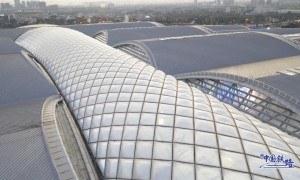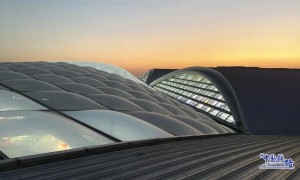Another Day in Katerradise
Last week the construction startup Katerra declared that it was shuttering it’s US operations, putting another L on the board for Softbank’s Vision Fund. It is walking away from numerous in-progress construction projects, its employees are being let go, and its assets are being sold.
上周,建筑初创公司Katerra宣布将关闭其美国业务,在软银愿景基金(Softbank Vision Fund)的董事会上再添一个L。它正在退出大量在建项目,它的员工正在被解雇,它的资产正在被出售。
The immediate cause of Katerra’s bankruptcy seems to be the bankruptcy of Greensill Capital, another Softbank-backed startup. At the beginning of 2021, under severe financial strain, Katerra underwent a recapitalization that cut its valuation by 90% (from $4 billion down to $400 million). As part of this, Katerra negotiated away a $440 million debt owed to Greensill, a supply chain finance company. But a few months later, Greensill itself went bankrupt, and the owners of this debt (Credit Suisse) are claiming that Katerra still owes it, which is apparently preventing the company from getting construction bonding. Since the debt is more than the current value of the company, that obviously presents a challenge.
导致Katerra破产的直接原因似乎是另一家由softbank支持的初创公司Greensill Capital的破产。2021年初,在严重的财务压力下,Katerra进行了资本重组,将其估值从40亿美元降至4亿美元,降低了90%。作为协议的一部分,卡特拉通过谈判解除了对供应链金融公司格林希尔(Greensill)的4.4亿美元债务。但几个月后,Greensill本身也破产了,债务的所有者(瑞士信贷)声称Katerra仍然欠着这笔债务,这显然阻止了该公司获得建筑担保。由于债务超过了公司的当前价值,这显然是一个挑战。
Despite the scale of Katerra (it raised over $2 billion in venture capital, had offices in 9 countries, and employed over 8000 people at its peak), very little information about the company’s internal operations was ever public, and it got comparatively little press attention. Most of the takes and analyses diagnosing Katerra’s problems aren’t particularly well-informed – none, for instance, even get Katerra’s basic business model correct.
尽管Katerra规模庞大(它筹集了超过20亿美元的风险投资,在9个国家设有办事处,在鼎盛时期雇佣了8000多名员工),但关于公司内部运作的信息却很少公开,相对来说也很少受到媒体关注。大多数对卡特拉的问题进行诊断和分析并不是特别有见地——例如,没有一个人甚至能正确掌握卡特拉的基本商业模式。
I worked at Katerra for 2.5 years, from early 2018 to the end of 2020, and had a first-hand look at how a company that seemed so promising ended up where it did. Since no one has yet written anything that really captures what it was like there, or what Katerra was trying to do, I figured I would try.
我在Katerra工作了两年半,从2018年初到2020年底,亲眼目睹了一家看起来很有前途的公司是如何发展成现在这样的。因为还没有人写过任何东西能真正捕捉到那里的样子,或者卡特拉想要做什么,我想我应该试试。
The Beginning
初衷
Katerra was originally founded in 2015 by Michael Marks, the former CEO of Flex, a contract electronics manufacturer. Marks grew Flex (then Flextronics) into the largest contract electronics manufacturer in the world [0], growing it’s revenue from under $100 million to over $14 billion during his tenure.
Katerra最初是由合同电子制造商Flex的前首席执行官Michael Marks于2015年创立的。马克带领Flex(当时的伟创力)成长为全球最大的电子产品合同制造商[0],在他的任期内,公司的收入从不足1亿美元增长到140亿美元以上。
The origin story of Katerra was that Marks was at lunch with a real estate developer, who pointed out a couple of his projects under construction nearby. Marks made a comment to the effect of “you must be getting a great deal on your toilets, since with two projects you’re buying so many of them”. The developer explained that that wasn’t how construction worked – the projects were with different architects, different contractors, and there weren’t really bulk purchasing discounts.
卡特拉最初的故事是这样的:当时马克斯和一位房地产开发商共进午餐,后者指出了附近他正在建设的几个项目。Marks评论说:“你们的厕所一定买得很划算,因为有了两个项目,你们就买了这么多。”开发商解释说,这不是建设的方式——项目由不同的建筑师、不同的承包商参与,而且没有真正的大宗采购折扣。
The story itself is probably apocryphal, but that’s the opportunity Katerra was originally founded to address. Success in electronics manufacturing requires a ruthlessly efficient supply chain, and Katerra was originally founded as a supply chain and logistics company. The company would source building materials inexpensively and in bulk from China and other places.
这个故事本身可能是虚构的,但这正是卡特拉创立之初要解决的问题。电子制造业的成功需要一条冷酷高效的供应链,而Katerra最初是一家供应链和物流公司。该公司将从中国和其他地方以低廉的价格大量采购建筑材料。
As the story goes, this business model didn’t really work – architects and designers weren’t willing to specify Katerra’s products, they wanted to use what they were familiar with. So early on Katerra pivoted to become a completely vertically integrated construction company. They would still source their own materials, but use them in Katerra designed and built buildings [1].
随着故事的发展,这种商业模式并没有真正起作用——建筑师和设计师不愿意详细说明Katerra的产品,他们想使用他们熟悉的产品。所以Katerra很早就转型成为一家完全垂直整合的建筑公司。他们仍然使用自己的材料,但在卡特拉的设计和建造建筑中使用它们。
Compared to the electronics manufacturing world, I’m sure the construction world looked astonishingly primitive, and modernizing it became another key part of Katerra’s value proposition. Instead of laboriously constructing buildings one at a time, by hand, buildings would be built the way everything else was built – prefabricated in a factory, designed specifically to be manufactured as efficiently as possible. Instead of designing buildings from scratch every single time, Katerra would have building products: standard, off the shelf buildings that could be customized for a client’s needs, the same way mass produced cars offer a wide variety of trim options.
与电子制造世界相比,我敢肯定建筑世界看起来非常原始,现代化成为了卡特拉价值主张的另一个关键部分。建筑将以其他所有建筑的建造方式建造——在工厂里预制,专门设计尽可能高效地制造,而不是一次一个地费力地手工建造。比起每次都从零开始设计建筑,Katerra将拥有建筑产品:标准的、现成的建筑,可以根据客户的需求定制,就像大批量生产的汽车提供各种各样的装饰选择一样。
This was the Katerra playbook when I joined the company. They would design a series of building products that could be mass-produced in their own factories, leveraging economies of scale and advanced manufacturing to build more efficiently than conventional construction. These products would be full of Katerra-supplied materials – everything from lightbulbs, to countertops, to bathroom fixtures, to appliances would all be Katerra brand. They would acquire general contractors in different markets to give them a nationwide construction footprint, and hire the various trades to self-perform all the construction work. At the time, I thought this was the exact right strategy needed to change the construction industry – it couldn’t be done piecemeal, it needed to be done all at once, simultaneously attacking every stage in the process.
这是我加入卡特拉公司时的剧本。他们将设计一系列可以在自己的工厂大规模生产的建筑产品,利用规模经济和先进的制造业,以比传统建筑更高效地建造。这些产品将充满Katerra提供的材料——从灯泡,到台面,到浴室装置,到电器,所有的东西都将是Katerra品牌。他们会在不同的市场上收购总承包商,从而在全国范围内建立自己的建设足迹,并雇佣不同行业的人自行完成所有的建设工作。当时,我认为这是改变建筑业所需要的完全正确的策略——它不能零敲碎打地完成,它需要一次性完成,同时攻击过程中的每一个阶段。
Scaling Up
扩张期
I joined Katerra early 2018; my role was to help grow and manage the Atlanta structural engineering team, which would be part of an Atlanta-based team of architects and engineers. By then Katerra was already a large company – I was somewhere around employee number 1000, and in North America alone Katerra already had offices in Menlo, San Francisco, Seattle, Vancouver, Spokane, and Phoenix. Worldwide, they had locations in India, UAE, Dubai, and China. They had already built factories in Phoenix and Spokane, and had more planned for California, Texas, and the southeast.
我于2018年初加入Katerra;我的职责是帮助发展和管理亚特兰大结构工程团队,该团队将是亚特兰大架构师和工程师团队的一部分。那时,Katerra已经是一家大公司了——我大约有1000名员工,仅在北美,Katerra就已经在门洛、旧金山、西雅图、温哥华、斯波坎和凤凰城设有办事处。在世界范围内,他们在印度、阿联酋、迪拜和中国都有分店。他们已经在菲尼克斯和斯波坎建立了工厂,并计划在加利福尼亚、德克萨斯和东南部建立更多的工厂。
In those days, Katerra’s goal was scaling up as fast as possible. In less than a year the Atlanta structural engineering team went from 3 to 11 people. Katerra was an ambitious company tackling the biggest problems in the construction industry, and that helped us recruit extremely talented and motivated people. People point to Katerra as an example of the mis-steps by non-industry veterans, but we actually had an incredibly easy time recruiting extremely knowledgeable, experienced industry folks who were sold on the vision – the entire structural department (40+ people spread across 5 offices) ended up being a real murderer’s row of talent [2].
在那些日子里,卡特拉的目标是尽可能快地扩大规模。在不到一年的时间里,亚特兰大的结构工程团队从3人变成了11人。Katerra是一家雄心勃勃的公司,致力于解决建筑行业最大的问题,这帮助我们招募到极具才华和积极性的人才。人们把Katerra作为非行业资深人士失误的一个例子,但我们实际上非常轻松地招募了非常有知识、有经验的行业人士,他们被我们的愿景所说服——整个结构部门(40多人分布在5个办公室)
It was an exciting time in the company – I joined just a few days after Katerra had secured $865 million in financing from Softbank, and there seemed to be unlimited opportunity ahead of us. After a few months in various WeWorks, we moved into the extremely plush offices of an architect Katerra had acquired (temporary quarters until the buildout of an entire floor to contain the future 150+ person team was complete). We joked that our marketing materials were constantly out of date, as by the time they were printed we had hired more people and opened more offices. In that year Katerra would octuple in size, growing to over 8000 employees.
这是公司令人兴奋的时刻——我加入公司的几天前,Katerra刚刚从软银获得了8.65亿美元的融资,我们似乎有无限的机会。在不同的WeWorks工作了几个月后,我们搬进了Katerra买下的一间极其豪华的办公室(临时住所,直到整个楼层的建造完成,以容纳未来的150多人团队)。我们开玩笑说,我们的营销材料总是过时,因为到它们印刷出来的时候,我们已经雇了更多的人,开设了更多的办公室。在那一年,卡特拉的规模扩大了八倍,员工超过8000人。
Katerra’s Building Systems
Katerra的建筑系统
Katerra had ambitions to eventually construct buildings of all types, but it initially pursued the multifamily residential market. Its buildings were based on light framed, panelized wood construction – Katerra’s factories would produce prefabricated wall panels and floor cassettes (floor trusses joined by sheathing into a single floor panel). This is a fairly common building system, but Katerra hoped to differentiate themselves by using panels with a higher level of completion: Katerra panels would have windows, plumbing stacks, and electrical boxes all pre-installed in the factory. The goal was to eventually produce fully enclosed, high level of completion panels that would contain all the required building systems (including drywall and exterior finishes), and could be erected on site with almost no field work required. It was an ambitious goal – I’m not aware of anyone in the industry doing it at scale.
卡特拉的目标是最终建造所有类型的建筑,但它最初追求的是多户型住宅市场。它的建筑基于轻型框架,镶板木结构——Katerra的工厂将生产预制墙板和地板盒(地板桁架通过覆盖连接成一个单一的地板板)。这是一种相当常见的建筑系统,但Katerra希望通过使用更完整的面板来区分自己:Katerra面板将有窗户、管道烟囱和电气盒,所有这些都预先安装在工厂。最终的目标是生产完全封闭的,高水平的完成面板,将包含所有所需的建筑系统(包括干墙和外部饰面),并可以在现场安装,几乎不需要现场工作。这是一个雄心勃勃的目标——据我所知,业内还没有人这么大规模地这么做。
We’ve covered the difficulties of making a factory-built housing system profitable ad-nauseum. But Katerra’s business model actually gave them a lot more leeway to make the model work. They could (theoretically) afford to sell buildings for at or near cost, and simply use them as a vehicle to sell as many building materials as possible (similar to how manufactured home builders often make a large fraction of their profits from financing the homes). But the economics of factory production still hold – making the numbers work requires maximizing your factory’s production volume. Katerra planned to do this with a series of standard, off-the-shelf buildings that it could prefabricate and sell all over the country.
我们已经讨论了使工厂建造的住房系统有利可图的困难。但是Katerra的商业模式实际上给了他们更多的空间让这种模式发挥作用。他们(理论上)可以负担得起以成本或接近成本的价格出售建筑,并将其作为一种工具,尽可能多地销售建筑材料(类似于制造房屋的建筑商通常从资助房屋中获得很大一部分利润)。但是工厂生产的经济效益仍然存在——使数字工作需要最大化你的工厂的产量。Katerra计划用一系列标准的、现成的建筑来实现这一目标,这些建筑可以预制并在全国销售。
Katerra Products
Katerra产品
Katerra’s various product offerings, via https://katerra.com/
Katerra’s products were what would differentiate them from conventional construction, as well as from more “traditional” modular construction. The company saw a huge opportunity in the fact that conventional construction was dominated by custom, one-off designs, and invested heavily in the idea of productizing entire buildings – off-the-shelf building designs that had been designed for maximum fabrication efficiency, and could be built better, faster and cheaper than anything conventional construction could match. In retrospect, the way this was executed seems like another page out of the electronics manufacturing playbook – Katerra planned on designing products based on customer’s specifications, while also offering their own in-house line of products.
Katerra的产品将它们与传统建筑以及更“传统”的模块化建筑区别开来。该公司看到了一个巨大的机遇,传统建筑是由定制的,一次性的设计,并投资大量的想法,生产整个建筑-现成的建筑设计,已被设计为最大的制造效率,可以建造得更好,比任何传统建筑都更快更便宜。回顾过去,这种方式似乎是电子制造剧本的另一页——Katerra计划根据客户的规格设计产品,同时也提供自己的内部产品线。
The product development effort simultaneously felt both enormous and chronically understaffed. There were hundreds of people working in product development (though a relatively small fraction of them were actual engineers or designers), and the number of products in development at one time was staggering. In addition to entire buildings, the product development effort included individual building systems and components, as well as construction software. I’ve done my best to compile a full list below:
产品开发的努力同时感到巨大和长期人手不足。有数百人从事产品开发工作(尽管其中相对较少的一部分是真正的工程师或设计师),同时开发中的产品数量惊人。除了整个建筑之外,产品开发工作还包括单个建筑系统和组件,以及建筑软件。我尽我所能列出了一个完整的列表:
-
Buildings
-
Garden apartments (K3)
-
Large multifamily apartment building (Corridor)
-
Workforce housing building (K4)
-
Midrise mass timber office building (MTOP, later MROP)
-
High rise residential building
-
Industrial building with CLT walls
-
Single family home
-
Precast home for construction in Saudi Arabia
-
Construction office product (KROC)
-
10-story multifamily building for India (K10)
-
Building Systems
-
Fast foundation system
-
CLT panels
-
Prefab bathroom kit
-
Prefab kitchen kit
-
Air conditioning system (KTAC)
-
Energy storage system (KES)
-
Katerra windows
-
Katerra cabinets
-
Raised office floor made from CLT
-
Conference room partition system
-
Low-carbon concrete (K-Crete)
-
CLT façade system
-
Software
-
Apollo, a suite of construction management software
-
Automated building design software
-
Tenant management app for use by landlords
And this doesn’t include the materials Katerra was developing and selling. Among these was Katerra’s own brand of appliances and fixtures (KOVA), some of which were rebranded products built by other factories, some of which had been designed internally (such as some lighting products).
这还不包括卡特拉开发和销售的材料。其中包括Katerra自己的家用电器和固定装置品牌(KOVA),其中一些是由其他工厂重新命名的产品,一些是内部设计的(比如一些照明产品)。
These products varied in the amount of attention given to them. Some of them (like the garden apartment) had hundreds of employees, millions of dollars in development budget, and years of design time. But many others lacked the resources required for a serious development effort, and operated with a shoestring budget and a tiny staff.
这些产品受到的关注各不相同。其中一些(如花园公寓)拥有数百名员工、数百万美元的开发预算和多年的设计时间。但其他许多国家缺乏开展认真的发展工作所需的资源,并且只有很少的预算和很少的员工。
Ideally, early stage product development involves rapid iteration and prototyping, to figure out what needs to be built as quickly as possible. But the pace of product development at Katerra always felt sluggish. Products would spend months or years in various stages of design without ever so much as a prototype being constructed. (the garden apartment product mentioned above had just begun construction of the first prototype project, after 3+ years of development, when the company shut down).
This was in part due to the difficulty of getting prefabricated construction cost-competitive with site built – designs would get sent to estimating, come back with a cost that was too high, and go back for redesign. Most of the products spent their entire life lingering in the design phase (the ones that I’m aware of making it into actual production were the precast home, the lighting, the bathroom and kitchen kits, and the windows).
理想情况下,早期产品开发包括快速迭代和原型设计,以尽可能快地确定需要构建什么。但在Katerra,产品开发的步伐总是显得缓慢。产品会在不同的设计阶段花费数月或数年时间,甚至连原型都没有建立起来。(上述花园公寓产品在经过3年多的开发后,刚刚开始建设第一个原型项目,公司就倒闭了)。
这在一定程度上是由于预制装配式建筑的成本难以与现场建造的成本竞争——设计会被送去估算,回来时成本太高,然后再回去重新设计。大多数产品的一生都停留在设计阶段(据我所知,将其转化为实际生产的产品包括预制房屋、照明设备、浴室和厨房用具以及窗户)。
CLT
One material Katerra sold that deserves closer examination is CLT. CLT is a mass timber panel product, sort of like a super plywood. CLT panels are made with alternating layers of dimensional lumber, resulting in large panels that can be used as the floors, walls, and roof of a building. CLT is a comparatively new building material – it was developed in Europe in the 90s, but has seen relatively little use in the US.
Katerra bet very heavily on CLT, investing somewhere in the neighborhood of $100 million on a plant for producing it, and for a while it was a defining aspect of the company (I remember brushing up on the PRG-320 guide on the plane ride out to the interview). As part of this, Katerra acquired a lot of high-end mass timber design talent (including the architecture firm MGA and the engineering firm Equilibrium, both of which specialize in mass timber). Emphasizing CLT almost certainly helped out recruiting efforts, at least on the design side – there’s a lot of enthusiasm for the product in the architecture and engineering world.
卡特拉出售的一种值得仔细研究的材料是CLT。CLT是一种大型木板产品,有点像超级胶合板。CLT板是由不同尺寸的木材层交替制成的,由此产生的大面板可以用作建筑物的地板、墙壁和屋顶。CLT是一种相对较新的建筑材料——它于90年代在欧洲开发,但在美国使用相对较少。
卡特拉在CLT上押了很大的赌注,投资了大约1亿美元的工厂来生产CLT,有一段时间,CLT是公司的一个决定性的方面(我记得在去接受采访的飞机上温习了PRG-320指南)。作为这个项目的一部分,Katerra获得了许多高端的大型木材设计人才(包括建筑公司MGA和工程公司Equilibrium,这两家公司都专门从事大型木材设计)。强调CLT几乎肯定帮助了招聘工作,至少在设计方面——在建筑和工程领域有很多对该产品的热情。
There’s actually a lot to like about making CLT part of the business model. Since it’s a high-end material, it immediately helps differentiate your product from what people typically imagine when they think of “factory produced housing”. It’s factory built and panelized, dovetailing nicely with the rest of Katerra’s prefab building systems. It’s environmentally friendly, and upcoming building code changes make it easier to specify. It seems like a case of skating to where the puck will be – CLT’s rising popularity and limited availability meant Katerra could have been a major producer in an expanding market. For a company whose bread and butter was material sales, it seems like an astute choice.
将CLT作为商业模式的一部分有很多值得称道的地方。由于它是一种高端材料,它能立即帮助你将你的产品与人们通常想象的“工厂生产的住房”区分开来。它是工厂建造和镶板,与卡特拉的其他预制建筑系统非常吻合。它是环境友好的,并且即将进行的建筑代码更改使其更容易指定。这似乎是一个滑冰的例子,冰球将是- CLT的日益普及和有限的可用性意味着Katerra可以成为一个主要生产商在一个不断扩大的市场。对于一家以物质销售为生计的公司来说,这似乎是一个明智的选择。
The problem is that once that decision was made, it was hard to change direction. The Katerra CLT factory could produce something like 10% of the total global supply of CLT, which required selling a LOT of it. This ended up being difficult to do – CLT is an expensive product, and an easy target for value engineering if project costs are too high (we ended up seeing it get cut from a lot of projects). I suspect the recent lumber price increases have only made this issue worse.
问题是,一旦做出了决定,就很难改变方向。卡特拉的交叉层压板工厂可以生产全球交叉层压板总供应量的10%左右,这需要大量销售。这最终是很难做到的——CLT是一种昂贵的产品,如果项目成本太高,它很容易成为价值工程的目标(我们最终看到很多项目都削减了它)。我怀疑最近木材价格的上涨只会让这个问题变得更糟。
Acquisitions
兼并
In addition to Katerra’s rapid hiring (dozens and dozens of new hires every week), Katerra also grew through acquisitions. Acquisitions were, broadly, focused on two areas: providing Katerra a nationwide construction footprint (by acquiring contractors such as Fields, Fortune Johnson, and UEB), and acquiring design capabilities (in addition to Equilibrium and MGA, Katerra also acquired several other architects in the US and abroad). But there were plenty of other acquisitions as well – a lighting supplier, a concrete contractor, and a software company to name a few. One of the largest deals was a merger with KEF Infra, a massive precast concrete company in India.
除了快速招聘员工(每周招聘数十名新员工),Katerra还通过收购实现增长。收购主要集中在两个领域:通过收购Fields、Fortune Johnson和UEB等承包商,为Katerra提供一个全国性的建设足迹,以及获得设计能力(除了Equilibrium和MGA, Katerra还在美国和海外收购了其他几家建筑师)。但也有很多其他的收购,例如一个照明供应商,一个混凝土承包商,和一个软件公司。最大的交易之一是与印度大型预制混凝土公司KEF Infra的合并。
Most of these companies continued to operate similarly to the way they did pre-acquisition. The design companies continued to bid for work, the contractors continued to build outside projects, etc. This gave the company a large number of revenue streams, but it also meant Katerra often had trouble operating as a single, unified whole [3]. Theoretically, all the different divisions could have been each other’s clients – engineers, architects, contractors and trades all working together on the same projects. But in practice this proved difficult – most of these groups already had folks they were comfortable working with, and it probably seemed needlessly risky to switch to working with a team they had no experience with, whether they were part of the same company or not.
这些公司中的大多数继续以与收购前类似的方式运营。设计公司继续投标工作,承包商继续建造外部项目等。这给公司带来了大量的收入来源,但也意味着Katerra作为一个单一的、统一的[3]整体运营时经常遇到麻烦。从理论上讲,所有不同的部门都可能是彼此的客户——工程师、建筑师、承包商和各行各业的人都在一起为同一个项目工作。但在实践中,这被证明是困难的——这些团队中的大多数已经有了他们愿意与之共事的人,而且,无论他们是否是同一家公司的成员,转向与他们没有经验的团队合作似乎是没有必要的风险。
There never ended up being systems in place to facilitate different business units working together – it remained difficult throughout my time at the company. So for instance, the engineering team almost never worked with the renovations department, despite having several engineers very experienced with renovation work.
最终没有一个系统能够促进不同的业务部门一起工作——这在我在公司的整个时间里都很困难。例如,工程团队几乎从来没有和翻新部门合作过,尽管有几个工程师在翻新工作上非常有经验。
This meant that any initiative that crossed business unit lines ended up being a constant source of headaches and frustration. An example: a change on an active project that would have resulted in a million dollar savings took months of internal negotiation to push forward, because it would have changed the scope of work for the engineering team. This sort of local optimization was rampant, and often left a lot of potential improvements on the table. The fact that nearly every division was expected to be a profit center probably exacerbated this. For instance, we asked for months for a way to track time that would allow us to assist an acquired architect (that we were sharing an office with) on early stage project work. We were ultimately told not to do this, and spend our time on billable things.
这意味着任何跨业务单元线的计划最终都会成为头痛和挫折的持续来源。例如:在一个活动项目上的一个变更将会导致一百万美元的节省,但是它需要几个月的内部协商才能推进,因为它将会改变工程团队的工作范围。这种局部优化非常猖獗,并且经常在表上留下很多潜在的改进。事实上,几乎每个部门都被认为是一个利润中心,这可能加剧了这一点。例如,我们花了几个月的时间来追踪时间,以帮助我们所获得的架构师(我们与他共用一间办公室)进行项目的早期工作。我们最终被告知不要这样做,并把时间花在可计费的事情上。
Bureaucracy
官僚主义
In some ways Katerra had the worst aspects of both a young, nimble startup, and a large, entrenched bureaucracy. The rapid growth meant that everything was constantly in flux (reporting structures, department goals, even office locations), but the sheer size of the company meant that things were extremely difficult to change deliberately. Each new acquisition and hire added more stakeholders, and changed the way that decisions got made.
在某些方面,卡特拉拥有一个年轻、灵活的初创公司和一个庞大、根深蒂固的官僚机构最糟糕的方面。快速增长意味着一切都在不断变化(报告结构、部门目标,甚至办公地点),但公司的规模意味着,要刻意改变这些事情是极其困难的。每一次新的收购和招聘都会增加更多的利益相关者,并改变决策制定的方式。
Every company inevitably develops informal channels and processes of how things are accomplished – who has the knowledge about a particular initiative, who can be pushed on to loosen a potential blockage, who you have to follow up with, who not to engage, etc. With the constant acquisitions and scaling up, and the lack of deliberate integration of acquired businesses units, this landscape was constantly shifting, making it hard to keep things moving forward.
每个公司都不可避免地会发展出一些非正式的渠道和流程,来说明事情是如何完成的——谁对某项计划有了解,谁可以被推进去疏通潜在的障碍,你必须跟谁跟进,谁不能参与,等等。随着不断的收购和扩大规模,以及对收购的业务单元缺乏有意的整合,这种情况不断变化,使得事情很难继续向前发展。
I suspect this is part of the reason for the slow pace for product development. New people would come in as a result of acquisitions, or get shifted around, and the product direction would change. It took a huge effort to just maintain forward progress, simply due to the entropy of the company structure. The amount of people required to sign off on a change kept going up, and as the company grew each approval got harder to receive, as demands on the approvers time went up. Things that could have been tested in a single weekend by a small, scrappy company would drag on for months at a time.
我怀疑这是产品开发缓慢的部分原因。新员工会因为收购而进入公司,或者被调动,产品的方向也会改变。仅仅是为了保持前进,就需要付出巨大的努力,这仅仅是因为公司结构的混乱。需要在变更上签字的人数不断增加,随着公司的发展,每个批准都越来越难获得,因为对批准人的要求时间也在增加。一些原本可以在一个周末内就被一家小公司测试出来的东西每次都会拖上几个月。
For instance, one of the necessary parts of the building product development was creating a software workflow that could translate Revit data into a set of instructions read by the factory equipment. The number of stakeholders involved meant there was no good way of rapidly experimenting to figure out the best method and implement it. As a result, months of effort would get spent trying to get a particular solution to work.
例如,建筑产品开发的一个必要部分是创建一个软件工作流,可以将Revit数据转换成一组由工厂设备读取的指令。涉众的数量意味着没有好的方法来快速试验找出最好的方法并实施它。结果,人们会花几个月的时间来尝试一个特定的解决方案。
Product Market Fit
市场匹配
Anyone looking for them can find plenty of horror stories about Katerra – projects that were delayed and over budget, mistakes that were made when setting up the factories, outrageous levels of spending, etc. But every large company, especially one that is rapidly growing, has horror stories. Katerra spent money like it was going out of style (at one point they had two company jets leased), but so did plenty of successful startups. Katerra had an incredibly frustrating bureaucracy, but all large companies have incredibly frustrating bureaucracies. Katerra had some projects go sideways, but every construction company has projects go sideways. Anecdotal descriptions of problems don’t provide much information, because we’d expect a lot of problems whether or not Katerra was succeeding. We need to look a bit deeper to diagnose the structural issues with the company.
任何寻找他们的人都可以找到大量关于卡特拉的恐怖故事——项目被推迟和超出预算,在建立工厂时犯下的错误,惊人的支出水平,等等。但每一家大公司,尤其是那些快速发展的公司,都有可怕的故事。Katerra花钱的样子就像它快要过时了一样(他们曾经租了两架公司飞机),但很多成功的初创公司也是如此。卡特拉有一些项目出了问题,但每个建筑公司都有项目出了问题。对于问题的轶闻描述并不能提供太多信息,因为无论Katerra是否成功,我们都预计会有很多问题。我们需要更深入地了解公司的结构问题。
Ultimately I think Katerra’s struggles can be traced to a lack of product-market fit. The company scaled up massively prior to having a product people wanted to buy, and it spent several fitful years (and painful pivots) trying to find one. Katerra started out heavily CLT focused, shifted more towards light framed wood, took a quick detour to cold formed steel, then went back to wood. An entire division was hired to self-perform construction work, then later eliminated. The engineering department was tasked with selling outside consulting services, then cut by 75% after we had lined up a backlog of work.
我认为,最终卡特拉的困境可以归结为产品与市场的不匹配。在推出人们想要购买的产品之前,该公司大规模扩张,并花了断断续续的几年时间(也经历了痛苦的转折)试图找到一款产品。Katerra开始着重于CLT,更多地转向轻质框架的木材,然后迅速转向冷成型钢材,然后又回到木材。整个部门被雇佣来自行执行建筑工作,然后被解雇。工程部门的任务是销售外部咨询服务,在我们完成积压的工作后,将其削减75%。
Each change stretched out timelines, and consumed massive amounts of resources in capital expenditures and design budgets. The pivot to cold formed steel, for instance, resulted in purchasing incredibly expensive CFS roll formers, acquiring CFS fabricators, hiring for CFS expertise, and completely redesigning several products.
每一个改变都延长了时间线,并消耗了大量的资本支出和设计预算资源。例如,转向冷成形钢,导致购买昂贵的CFS轧辊成型机,收购CFS制造商,雇佣CFS专家,并彻底重新设计了一些产品。
In some ways, this is a boring answer – the most likely thing to kill a startup, killed a startup. A pivot is hard enough at a small startup. It’s far harder at one that employs thousands of people, and has massive capital investments in building physical products.
在某种程度上,这是一个无聊的答案——最有可能扼杀一家创业公司的是,扼杀他的开始。对于一家小公司来说,支点是非常困难的。对于一家拥有数千名员工、在生产实体产品上有大量资本投资的公司来说,这要难得多。
What Goes Up…
后续
The first year and a half at Katerra was incredibly rewarding. Many of us worked incredibly long hours out of sheer enthusiasm and excitement. But as time went on the cracks began to show.
在卡特拉的第一年半是令人难以置信的收获。我们中的许多人纯粹出于热情和兴奋,工作时间长得令人难以置信。但随着时间的推移,裂痕开始显现。
Reorganizations continued to happen (in my first year, the engineering department was moved 3 times). Relatively straightforward management issues (like getting title bumps pushed through) somehow became impossible obstacles. Most worryingly, the flow of new projects slowed to a trickle. Products kept getting priced and coming back too expensive, or would go on hold and not come off. New projects failed to materialize.
重组也在不断发生(在我的第一年,工程部被调了3次)。相对简单的管理问题(如晋升)在某种程度上变成了不可能的障碍。最令人担忧的是,新项目的流入变得非常缓慢。产品不断被定价,回来的价格太高,或者会暂停销售,不会脱手。新项目未能实现。
The turning point (for me at least) was the end of Summer 2019. There was a massive series of layoffs that cut our group by 75%, and essentially obliterated everything we’d been working on and planned to accomplish.
转折点(至少对我来说)是2019年夏季结束时。当时公司进行了一系列大规模的裁员,将公司规模削减了75%,这让我们一直以来的工作和计划都付之东流。
Everything after that feels like sort of a rearguard action. Shortly after there would be a new CEO installed, and the company became laser focused on (sorely needed) cost reduction. The year that followed was a long, brutal series of layoffs (when I left in October of 2020, I had survived 5 or 6 rounds of layoffs, and there were more after I left). Perks and benefits were cut, the Phoenix factory was closed, R&D got slashed to the bone, and most product development efforts outside of a few critical ones were cancelled. Self perform was eliminated as well.
在那之后的一切都像是后卫行动。不久之后,新CEO上任,公司开始专注于(迫切需要的)降低成本。接下来的一年是漫长而残酷的裁员(当我在2020年10月离开时,我已经经历了5、6轮裁员,在我离开后还经历了更多)。津贴和福利被削减,凤凰工厂被关闭,研发被削减到最低限度,除了一些关键项目外,大多数产品开发工作都被取消了。自我表现也被排除了。
But the problems of scale continue to apply even when you try to de-scale. The lack of structure meant that management didn’t have good visibility on who needed to be let go and who should stay, and we frequently found that critical colleagues had been let go, leaving groups without the right resources or staff. Simply maintaining existing commitments became a herculean effort. I ended up leaving in October of 2020, prior to the recapitalization that cut the company’s valuation by 90% and wiped out existing shareholders).
但是规模的问题仍然存在,即使你试图去缩小规模。缺乏结构意味着管理层对谁该被解雇、谁该留下来没有很好的可见性,我们经常发现关键的同事被解雇,导致团队没有合适的资源或人员。仅仅是维持现有的承诺就成了一项艰巨的任务。最终,我在2020年10月离开了公司,当时公司还没有进行资本重组,公司的估值降低了90%,现有股东也没有了。)
It should be said that there’s likely a bit of narrative fallacy here – Katerra had some struggles but also a lot of bad luck: the WeWork blowup (which precipitated the focus on cost-cutting), the pandemic, the lumber price increase, the Greensill bankruptcy, . It’s easy to imagine that if one or two catastrophic things hadn’t happened, Katerra could have made it through, and become an amazing story of company survival. Anecdotally, up until the announcement they were closing last week, folks at the company seemed fairly pleased with the trajectory it was on.
应该说,这里可能有一些叙事上的谬误——卡特拉有一些挣扎,但也有很多坏运气:WeWork的崩溃(促使人们把注意力集中在削减成本上)、大流行、木材价格上涨、格林希尔破产。很容易想象,如果没有发生一两件灾难性的事情,Katerra可能会挺过来,并成为一个令人惊叹的公司生存故事。有趣的是,在上周宣布关闭之前,公司员工似乎对公司的发展轨迹相当满意。
Katerra was, in the words of Paul Graham, frighteningly ambitious. It planned on offering products that could cover 80% of the built environment (apartments, houses, hotels, office buildings, industrial buildings, and plenty more), and recruited an army of people who tried their absolute best to make it happen. You’ll find a huge number of ex employees that loved their time at Katerra, and consider it some of the most valuable and meaningful work they ever did. One anecdote for the extent that folks were bought in – during the call announcing the recapitalization (that wiped out existing stockholders) someone asked if employees would have the option to buy back into the company into the future). My LinkedIn has been completely flooded with “end of the road” type announcements, and nearly every one of them is about how much they valued the opportunity they had at Katerra.
用保罗·格雷厄姆的话来说,卡特拉野心勃勃。它计划提供能覆盖80%的建筑环境(公寓、住宅、酒店、办公楼、工业建筑等等)的产品,并招募了一大批人,他们竭尽全力来实现这一目标。你会发现很多前员工都热爱在Katerra的时光,并认为这是他们所做过的最有价值和最有意义的工作。在宣布资本重组(导致现有股东破产)的电话会议上,有人问员工是否有在未来买回公司股份的选择权。我的领英(LinkedIn)已经被铺天盖地的“走到尽头”之类的公告淹没了,几乎每一条都是关于他们有多重视在卡特拉(Katerra)获得的机会。
Katerra didn’t end up working, but I’m glad we had the opportunity to try.
卡特拉最终没有成功,但我很高兴我们有机会尝试一下。









